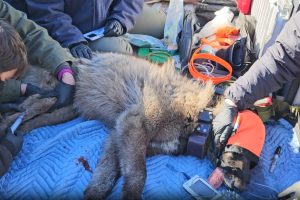Sonora, CA — California Department of Fish and Wildlife (CDFW) recently captured twelve gray wolves, collared them, and released them in northern California.
State wildlife officials anticipated that the increased number of satellite-collared wolves in California would enhance knowledge and management of the species.
“The captures exceeded our expectations and will enhance our ability to monitor our wolf population both for conservation and recovery and also to help mitigate conflict with livestock,” said Axel Hunnicutt, CDFW’s Statewide Gray Wolf Coordinator.
Capture efforts in Siskiyou, Lassen, Plumas, and Sierra counties were taken between January 14 and the end of that month. Wolves from the Whaleback, Harvey, and Beyem Seyo packs were taken into custody with the help of a capture crew and leased aircraft. Scientists measured each wolf’s physique, took biological samples, such as blood and DNA, and fitted each with a satellite collar. These samples enable CDFW to assess the relatedness of individuals and packs and to watch for illnesses in wolves. At the sites of their capture, the wolves were set free.
“The captures exceeded our expectations and will enhance our ability to monitor our wolf population both for conservation and recovery and also to help mitigate conflict with livestock,” said Axel Hunnicutt, CDFW’s Statewide Gray Wolf Coordinator.
CDFW provided these details about the 12 collared wolves: seven were female and five were male:
- Five were captured from the Beyem Seyo pack in Sierra County, including one that had been previously collared;
- Five were captured from the Harvey pack in Lassen County, including one that had been previously collared;
- Two were captured from the Whaleback pack in Siskiyou County.
To monitor populations, comprehend patterns of landscape usage, and reduce livestock conflicts, satellite-collaring gray wolves are a crucial management and research tool, said state wildlife officials. Real-time data is not provided by the collars. Rather, the collars gather wolf whereabouts many times a day and send them to CDFW regularly. The satellite collars have a two- to three-year battery life. They are set up to deliver the animal before the battery runs out.
There are seven wolf groups in California currently, according to CDFW. Wolf packs can fluctuate, even though nine packs were documented in the fall of 2024. CDFW expects to release its first yearly report on California gray wolf status in April. The CDFW gray wolf website has further details about California’s wolves.



